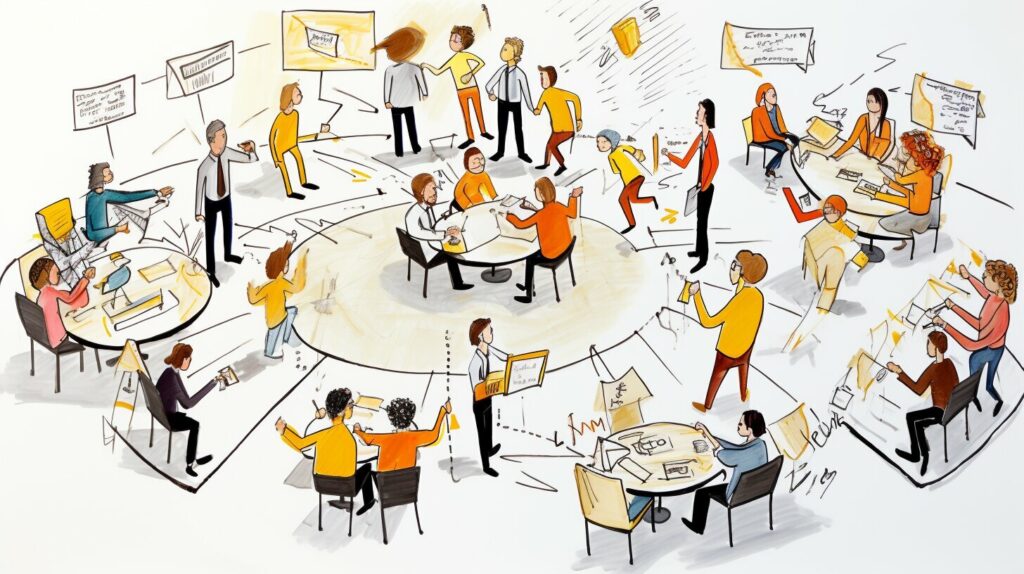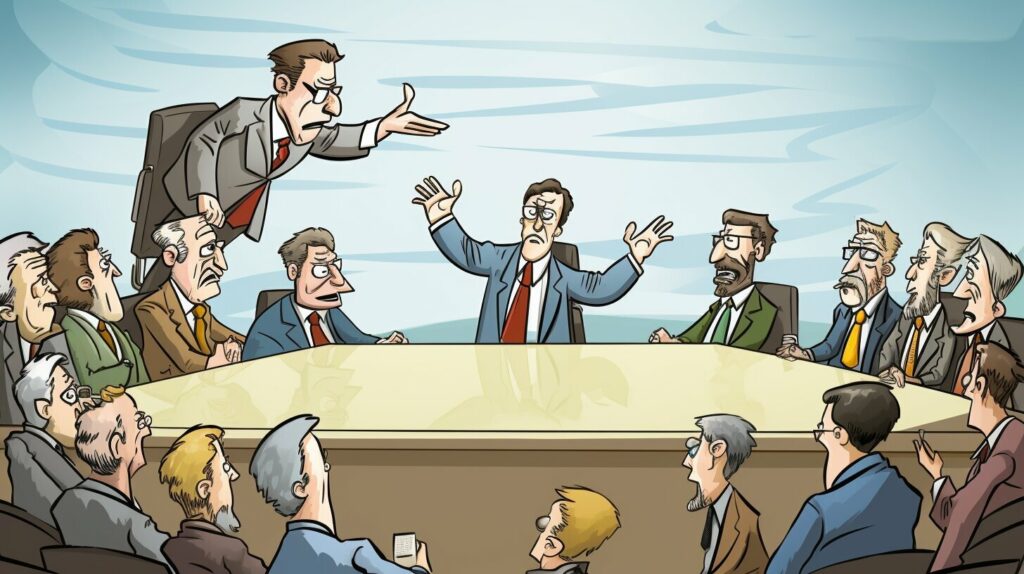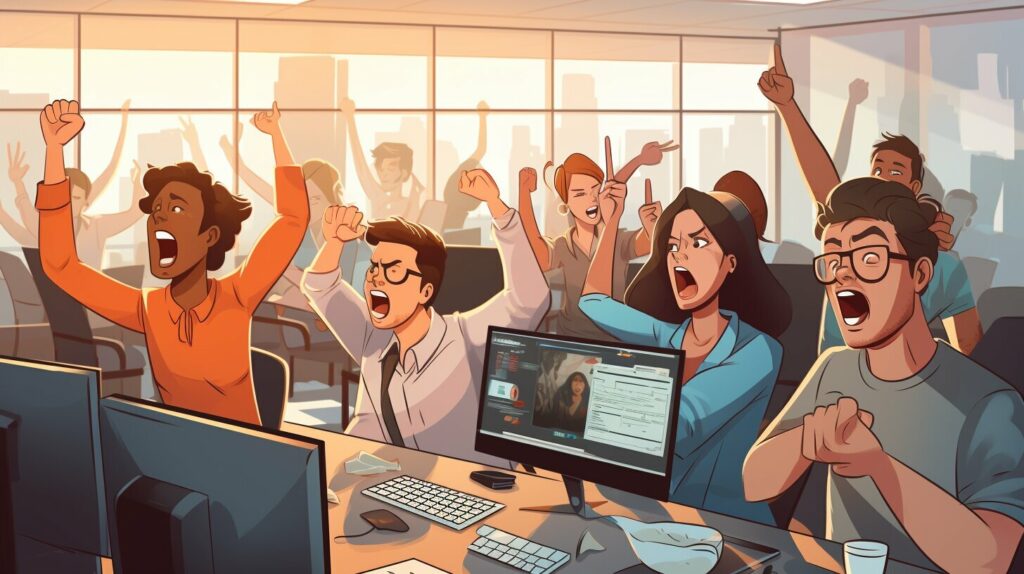Welcome to our comprehensive article about how leadership style affects team dynamics. As an experienced General Manager, I’ve spent years leading various teams, and I understand how vital good leadership is to a team’s success.
Leadership isn’t just about giving orders. It’s about inspiring and motivating people to work together towards shared goals. It’s about creating an environment where creativity can grow, where people are encouraged to work together, and where everyone can be productive.
In today’s world, where teamwork is essential for success, understanding the different ways to lead can make a significant difference.
Key Takeaways:
- Leadership style plays a critical role in shaping team dynamics.
- Effective leaders provide direction, foster a common goal, and create a sense of safety.
The Role of Leadership in Team Collaboration
Effective team collaboration is crucial for achieving business goals and improving overall productivity. However, team collaboration can be greatly influenced by leadership style.
How does leadership style affect team dynamics? Leaders who prioritize collaboration and teamwork tend to have a greater impact on team dynamics than those who do not.
They set the tone for the team and establish a culture of open communication, respect, and trust.
Research has shown that there are several effective leadership styles for promoting team collaboration, including:
| Leadership Style | Description |
|---|---|
| Transformational | This leadership style emphasizes communication, motivation, and team collaboration. Transformational leaders inspire and encourage their team members to work together towards a shared vision. |
| Servant | This leadership style prioritizes the needs and well-being of team members. Servant leaders encourage open communication, active listening, and the sharing of ideas. |
| Democratic | This leadership style involves team members in decision-making processes. Democratic leaders encourage collaboration and communication, resulting in a more engaged and committed team. |
| Coaching | Focuses on the personal and professional development of team members. Provides regular feedback, support, and opportunities for growth, building strong relationships and encouraging collaboration. |
| Laissez-faire | Gives team members the autonomy to manage their work and make decisions. Can foster a sense of responsibility and encourage creative problem-solving in the right environment. |
| Cross-functional | Creates teams with diverse skills and backgrounds. Encourages cross-functional collaboration, leveraging the unique strengths of each team member. |
| Adaptive | Flexible and responsive to change. Encourages team members to be agile and adapt to new challenges, fostering a culture of continuous learning and collaboration. |
| Inclusive | Actively seeks to create a diverse and inclusive environment where all team members feel valued and respected. Fosters a sense of belonging and encourages team members to collaborate and contribute their unique perspectives. |
These leadership styles can be tailored to the specific needs and dynamics of a team, and often, a combination of these styles may be employed to create a collaborative and effective working environment.
While these leadership styles can be effective for promoting team collaboration, it’s important to note that not every leadership style is suitable for every team. It’s crucial for leaders to adapt their style to their team’s specific needs and dynamics.
Ultimately, it is the responsibility of the leader to create an environment in which team members feel comfortable sharing ideas and collaborating with one another.
By prioritizing team collaboration and utilizing effective leadership styles, leaders can establish a culture of teamwork and achieve greater team dynamics in the workplace.

Enhancing Team Productivity through Leadership
How does leadership style affect team dynamics? Leadership styles and team performance play are critically connected. Effective leadership influence on team dynamics involves motivating and engaging their team members to produce quality work.
By setting clear expectations, providing feedback, and recognizing achievements, leaders can foster a sense of ownership and accountability among their team members, which can significantly improve productivity.
Moreover, leaders who communicate regularly and openly with their teams can ensure that everyone is on the same page regarding project goals and expectations. This clarity can prevent misunderstandings and delays, resulting in increased efficiency and productivity.
Leaders can also inspire their team members to go beyond their limitations and explore innovative ideas by encouraging creativity and experimentation.
By providing a safe environment for their team members to express themselves and take risks, leaders can improve team performance, motivation and engagement.

However, it’s important to note that different leadership styles can impact team productivity differently. For instance, authoritarian leadership styles may yield faster results in the short term, but can lead to burnout and decreased productivity in the long run.
On the other hand, transformational leadership styles, which focus on inspiring and empowering team members to achieve their best, have been linked to improved productivity and job satisfaction.
Leaders who build strong relationships with their team members can create a positive work environment where everyone is motivated to perform at their best.
From my experience, effective leadership plays a critical role in enhancing team productivity in agile management too. Through setting clear expectations, encouraging innovation, and fostering positive relationships, leaders can inspire their team members to perform at their best and achieve outstanding results.
Leadership Principles for Effective Team Dynamics
Effective leadership is crucial for ensuring a cohesive team that works together to achieve common goals. Here are some leadership principles that can contribute to effective team dynamics:
| Principle | Description |
|---|---|
| Leading by Example | Leaders who set a positive example for their team members inspire them to follow suit. By modeling desired behaviors, leaders can reinforce the values and goals of the team. |
| Fostering Open Communication | Effective communication is key to building trust and collaboration among team members. Leaders who encourage open communication create an environment where team members feel safe to express their opinions and ideas. |
| Promoting Trust and Accountability | Leaders who foster trust and accountability among team members create a culture of ownership and responsibility. When team members trust each other and feel accountable for their actions, they are more likely to work together productively. |
| Embracing Diversity | Leaders who value diversity recognize that each team member brings unique perspectives and experiences to the table. By embracing and celebrating diversity, leaders can create a more inclusive and innovative team culture. |
By applying these principles, leaders can create an environment where team members feel supported, motivated, and engaged. These diverse leadership styles can lead to improved communication, increased collaboration, and better outcomes.

Conflict Resolution and Leadership Style
Conflict is inevitable in any team environment, but how leaders handle it can greatly impact team dynamics. Different leadership styles can approach conflict resolution in varying ways.
Authoritarian leaders may try to suppress conflicts and impose their own solutions, which can lead to resentment and reduced trust among team members.
On the other hand, collaborative leaders may encourage open discussion and seek out mutually beneficial solutions. This approach can build team cohesiveness and strengthen relationships.
It’s important to note that conflict resolution isn’t just about finding a solution; it’s also about creating a positive team environment where conflicts are handled constructively.
Leaders can create such an environment by promoting healthy communication, encouraging honesty, and respecting individual perspectives.
In one study, it was found that teams with high levels of trust were better equipped to handle conflicts effectively and maintain productivity. This highlights the importance of a positive team culture in resolving conflicts.
By promoting open communication and fostering mutual respect, leaders can help build a culture of trust and collaboration that ultimately benefits the entire team.
“Team members who trust one another are more likely to engage in productive conflict.”, Patrick Lencioni, author of “The Five Dysfunctions of a Team,”

Open communication can also help prevent conflicts from escalating. Regular check-ins and feedback sessions can provide opportunities for team members to address issues before they become bigger problems.
Remember: leaders who approach conflict resolution with a collaborative mindset and promote a positive team culture can enhance team productivity and cohesiveness.
The Role of Emotional Intelligence in Leadership
Emotional intelligence plays a crucial role in effective leadership and team dynamics. Leaders who possess high emotional intelligence are better equipped to understand their own emotions and those of their team members.
This understanding allows leaders to manage emotions in a way that fosters positive relationships and productive collaboration.
At the core of emotional intelligence is self-awareness. Leaders who are self-aware are able to recognize their own emotions and how they impact their behavior and decision-making. This awareness helps leaders regulate their emotions and respond to challenges in a way that promotes a positive work culture.
In addition to self-awareness, emotional intelligence includes empathy and social skills. Leaders who are empathetic are able to understand and relate to the emotions of their team members. This understanding allows leaders to communicate effectively, build trust, and cultivate a sense of belonging within the team.
Social skills, such as communication and conflict resolution, are essential for effective leadership and team dynamics. Leaders with strong social skills are able to facilitate open communication, foster healthy conflict resolution, and promote a positive work environment.
By creating a culture of trust and collaboration, leaders with high emotional intelligence are able to enhance team performance and productivity.

To sum up, motional intelligence is a critical component of effective leadership and team dynamics. Self-awareness, empathy, and social skills are key elements of emotional intelligence that contribute to positive team collaboration, communication, and productivity.
Adapting Leadership Style in Remote Work Dynamics
In light of recent global events, remote work has become the new norm for many people. As such, leaders must adapt their leadership style to effectively lead remote teams. Clear communication and trust-building are the cornerstones of successful remote team collaboration.
Leaders must establish clear expectations and goals for their remote teams. Providing regular feedback and recognizing achievements are crucial for remote team morale and productivity. Utilizing technology and digital communication tools can help maintain team collaboration.
Emphasizing trust-building is essential for remote team success. Leaders must establish an environment of psychological safety, where team members feel comfortable sharing their thoughts and ideas. This can be fostered through active listening, being approachable, and creating opportunities for open communication.
Different leadership styles may be applicable for remote teams. Leaders must be flexible and willing to adapt their style to the needs of their team members.
For example, a transformational leadership style may be effective in motivating and engaging remote employees, while a democratic leadership style may be better suited for decision-making in a remote team setting.
Overall, effective leadership in remote work dynamics requires clear communication, trust-building, and adaptability. Leaders who prioritize these factors can successfully lead remote teams and foster positive team dynamics.

The Influence of Ethical Leadership on Team Dynamics
Leadership is not just about achieving goals and objectives. It is also about doing so in a way that is ethical and sustainable. Leaders who prioritize ethics and integrity create a positive work culture that builds trust among team members and enhances team performance.
According to a recent study, teams with ethical leaders are more likely to exhibit a strong commitment to their work, a greater sense of collaboration, and improved problem-solving skills.
This is because ethical leaders set clear expectations, foster open communication, and encourage team members to take ownership of their work.
Effective ethical leadership requires a commitment to transparency and accountability. Leaders must be willing to admit their mistakes and take responsibility for their actions. This creates a culture of honesty and trust, which is essential for building strong relationships within a team.
Furthermore, ethical leaders take the time to get to know their team members on a personal level, showing empathy and respect for their individual needs and values. This creates a sense of safety and belonging, which is essential for creating a positive and supportive work environment.
Overall, ethical leadership is crucial for fostering a culture of accountability, collaboration, and high performance within teams. By prioritizing ethics and integrity, leaders can build strong relationships with team members, enhance collaboration and problem-solving skills, and ultimately achieve long-term success.

The Importance of Organizational Culture in Team Dynamics
Organizational culture plays a crucial role in shaping team dynamics. It refers to the shared values, beliefs, and behaviors that define how things are done within a company or team.
Leaders have a significant influence on creating and maintaining the organizational culture, which can impact how team members interact and collaborate with one another.
A positive organizational culture can foster a sense of belonging and motivate team members to work together towards a common goal. On the other hand, a negative culture can create an environment of distrust and hinder team productivity.
Therefore, it is essential for leaders to establish a culture that aligns with their team’s values and goals.
| Strategies for creating a positive organizational culture: |
|---|
| Lead by example: Leaders who model the behavior they expect from their team members can set the tone for the entire team. |
| Foster open communication: Encourage dialogue and active listening among team members to promote transparency and trust. |
| Promote trust and accountability: Build trust among team members by emphasizing the importance of accountability and encouraging ownership of tasks and responsibilities. |
| Embrace diversity: Recognize and appreciate the unique strengths and perspectives of team members, creating an inclusive and supportive environment. |
Leaders who prioritize organizational culture can create a positive work environment that promotes collaboration, productivity, and overall team success.
By implementing these strategies and adapting to the needs of their team members, leaders can ensure that their team dynamics remain strong and resilient.

Conclusion
In conclusion, leadership style affects team dynamics. Effective leadership can provide direction, foster collaboration, enhance team productivity, and promote a positive work culture.
Through this article, we have explored various aspects of leadership style that influence team dynamics, such as emotional intelligence, ethical leadership, and the importance of organizational culture.
I encourage our readers to reflect on their own leadership styles and how they can adapt to better lead their teams. By incorporating some of the leadership principles and strategies discussed in this article, we can all work towards building stronger, more cohesive teams.
FAQ For How Does Leadership Style Affect Team Dynamics?
Q: How does leadership style affect team dynamics?
A: Leadership style plays a crucial role in influencing team dynamics. The way a leader approaches their role can impact how team members collaborate, communicate, and perform. Different leadership styles can either enhance or hinder team dynamics.
Q: What is the role of leadership in team collaboration?
A: Leadership style significantly influences team collaboration. Effective leaders can promote a collaborative environment by fostering open communication, building trust, and encouraging teamwork. On the other hand, poor leadership can hinder collaboration and lead to a fragmented team.
Q: How can leadership enhance team productivity?
A: Leadership style can greatly impact team productivity. Leaders who set clear expectations, provide feedback, and recognize achievements can motivate and engage team members, resulting in increased productivity. Effective leadership fosters a positive work environment that inspires team members to perform at their best.
Q: What are the key leadership principles for effective team dynamics?
A: Leading by example, fostering open communication, promoting trust and accountability, and embracing diversity are key leadership principles that contribute to effective team dynamics. These principles enable leaders to create a supportive and inclusive environment where team members can thrive.
Q: How does leadership style influence conflict resolution?
A: Leadership style plays a significant role in how conflicts are resolved within a team. Different leadership styles approach conflict resolution in various ways. Leaders who promote healthy conflict resolution and create a positive team environment can effectively manage conflicts and maintain a harmonious team dynamic.
Q: What is the role of emotional intelligence in leadership?
A: Emotional intelligence is crucial for effective leadership. Leaders with high emotional intelligence can understand and manage their own emotions and those of their team members. This ability enables them to create a supportive and empathetic environment, leading to improved team dynamics.
Q: How can leadership style adapt to remote work dynamics?
A: Remote work dynamics present unique challenges and opportunities for leadership. Leaders must prioritize clear communication, trust-building, and leveraging technology to maintain team collaboration and productivity. Adapting leadership style to the remote work context is essential for effectively leading remote teams.
Q: What is the influence of ethical leadership on team dynamics?
A: Ethical leadership has a profound impact on team dynamics. Leaders who prioritize strong ethical principles create a positive work culture, build trust among team members, and enhance overall team performance. Ethical leadership practices contribute to a cohesive and well-functioning team.
Q: How does organizational culture impact team dynamics?
A: Organizational culture plays a significant role in shaping team dynamics. Leaders have the power to influence the culture within their teams, which can impact collaboration, communication, and overall team performance. Creating a positive and supportive organizational culture is crucial for fostering a healthy team dynamic.

